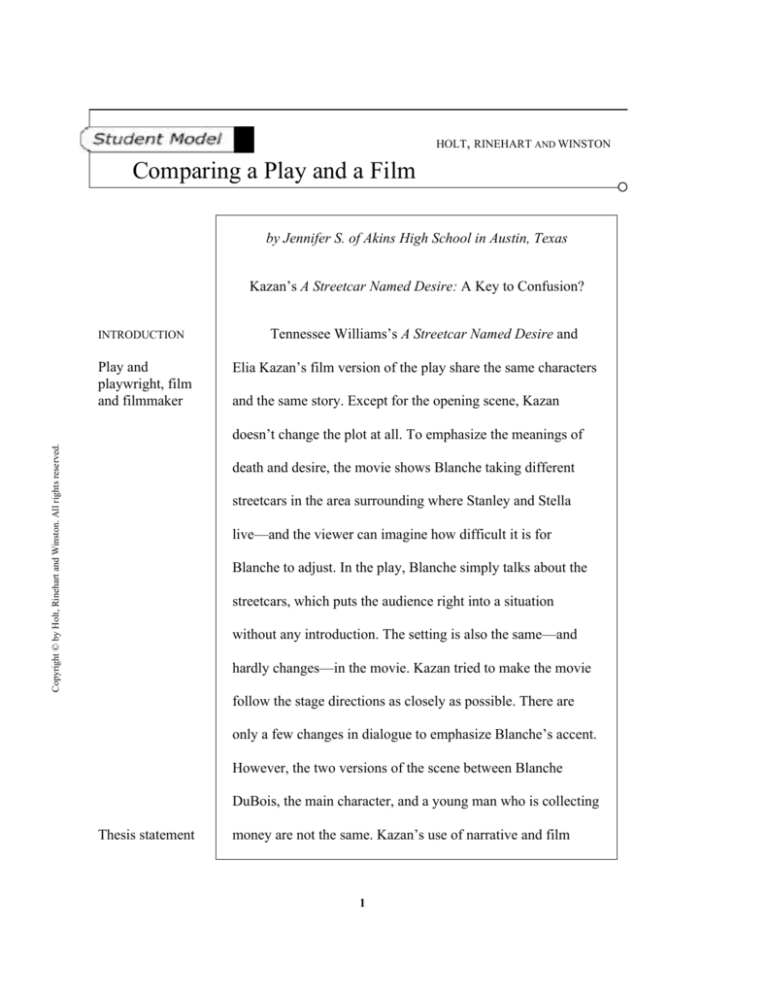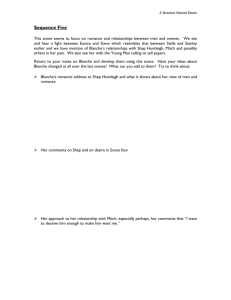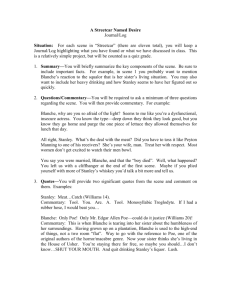
HOLT, RINEHART AND WINSTON
Comparing a Play and a Film
by Jennifer S. of Akins High School in Austin, Texas
Kazan’s A Streetcar Named Desire: A Key to Confusion?
INTRODUCTION
Play and
playwright, film
and filmmaker
Tennessee Williams’s A Streetcar Named Desire and
Elia Kazan’s film version of the play share the same characters
and the same story. Except for the opening scene, Kazan
Copyright © by Holt, Rinehart and Winston. All rights reserved.
doesn’t change the plot at all. To emphasize the meanings of
death and desire, the movie shows Blanche taking different
streetcars in the area surrounding where Stanley and Stella
live—and the viewer can imagine how difficult it is for
Blanche to adjust. In the play, Blanche simply talks about the
streetcars, which puts the audience right into a situation
without any introduction. The setting is also the same—and
hardly changes—in the movie. Kazan tried to make the movie
follow the stage directions as closely as possible. There are
only a few changes in dialogue to emphasize Blanche’s accent.
However, the two versions of the scene between Blanche
DuBois, the main character, and a young man who is collecting
Thesis statement
money are not the same. Kazan’s use of narrative and film
1
HOLT, RINEHART AND WINSTON
Comparing a Play and a Film
techniques helps the audience to visualize the play, but on the
other hand, confuses them as well.
BODY
Comparison of
narrative
techniques:
The main thing that differs in Scene 5 is the theme. In
this scene, Blanche flirts with the young man who is collecting
some money for a newspaper. Blanche doesn’t have any
money, but every time the boy tries to leave the room she
Copyright © by Holt, Rinehart and Winston. All rights reserved.
invents some new excuse to try to make him stay longer. In the
end of the scene, she kisses him without even waiting for his
Theme—play
response to her request. In the play, the young man seems
scared and shocked when Blanche approaches him. The stage
directions indicate, “The young man clears his throat and looks
yearningly at the door” (Williams 84). In the movie, however,
the boy never takes his eyes off Blanche. He stares at her the
whole time. When Blanche calls him back, the stage directions
indicate that “she crosses toward him,” but in the film version
Theme—film
that’s not true (83). As she approaches him, he also moves
toward her to meet her—not at the door, but in the middle of
the room. The incident repeats itself shortly before the kiss
when he doesn’t try to push her away, but instead leans
2
HOLT, RINEHART AND WINSTON
Comparing a Play and a Film
forward and doesn’t even try to stop. However, Tennessee
Williams’s stage directions state: “Without waiting for him to
accept, she crosses quickly to him and presses her lips to his”
(84). The change of theme doesn’t bother the audience much;
but if you know the real play, it’s difficult not to get confused.
The young man obviously enjoys his fate in the film version,
Copyright © by Holt, Rinehart and Winston. All rights reserved.
whereas in the play he is naive and scared.
Evaluation of
film techniques:
Important film techniques help the audience to visualize
the play. Although the movie is black and white, Kazan does an
1. Lighting
outstanding job in using different lighting effects. When the
young man enters, Blanche doesn’t know who it is because of
the light from outside. The darkness in the room lets the boy
appear as a big black shadow, which helps to emphasize her
interest in him when she finally realizes that it is a very young
man. All of a sudden, when he steps into the light, Blanche
can’t stop staring at the visitor.
Blanche is also never shown in the direct spotlight so
that no one can see her real age or looks. In the play it’s hard to
imagine how Blanche looks because there is not enough
3
HOLT, RINEHART AND WINSTON
Comparing a Play and a Film
concrete detail. The only time she is described in the light is
when Mitch turns it on. Here the stage directions indicate that
“he tears the paper lantern off the light bulb” (117). In the
movie it’s a whole lot easier to realize how much Blanche has
to depend on the light. Whenever she is seen, she is in a partly
darkened spot. The only time she is standing right in the
Copyright © by Holt, Rinehart and Winston. All rights reserved.
spotlight is after Mitch pushes her against the wall and holds a
light right into her face. In that moment, not only is Mitch
shocked, but also the whole audience finds out why Blanche
prefers the darkness. She is old and ugly! The film uses great
lighting effects to hide Blanche’s real looks and to create the
right atmosphere for the more intense scenes.
2. Camera shots
The camera shots in this particular scene are mostly
medium shots or close-ups. When Blanche speaks, the close-up
gives a good image of her interest in the young man. The closeups of the young man show his interest, too, which leads to the
difference and confusion between the play and the movie. If
Kazan would have used only medium shots of him, the
audience may not have realized that his appearance in the
4
HOLT, RINEHART AND WINSTON
Comparing a Play and a Film
movie differs from his appearance in the play. The camera
angles mostly show the two of them or one person alone
because they are the main figures in the scene, and nothing else
matters.
3. Sound effects
The sound effects are not that special and can be recreated in the play easily. The film music, however, tells a lot
Copyright © by Holt, Rinehart and Winston. All rights reserved.
about the scene’s importance. In the play, the music of the Four
Deuces is played in a blue mood. The music in the movie
varies from blue to childish. When Blanche is depressed and
sad, the music is blue and sad; but as soon as she sees the
young man standing in her room, it becomes the kind of
childish music you would hear in a music box. This type of
music continues through the whole scene and gets louder when
the boy is shown until Mitch, Blanche’s “Rosenkavalier,”
finally appears. The music gives the audience the right feeling
about Blanche and the difference in age between her and the
boy. In the play, it’s difficult to create an atmosphere of the
scene when the stage directions indicate, “The music of the
Four Deuces is played.” What kind of music do they play in the
5
HOLT, RINEHART AND WINSTON
Comparing a Play and a Film
Four Deuces? The stage directions obviously lack some
extremely important details because a blue and sad music can
be almost any type of music, and it’s impossible to hear it
radiating from a book.
CONCLUSION
Restatement of
thesis
Elia Kazan’s film version of A Streetcar Named Desire
is interesting, but in some scenes a little confusing to those who
Copyright © by Holt, Rinehart and Winston. All rights reserved.
have read the play. The benefits of film techniques entertain the
audience even more and emphasize the dramatic situations
Closing
statement
between the characters. While the plot of the movie hardly
differs from that of the play and the changes in the theme do
not affect the plot much, the audience won’t miss a lot if they
would rather watch the movie instead of reading or going to see
the original play at a theater.
6







